Foreign Insulators
by Marilyn Albers
Reprinted from "Crown Jewels of the Wire", January 1991, page 6
CAROL AND MARILYN CONDUCT INSULATOR
RESEARCH TRIP ON FOREIGN SOIL
PART III
In the last episode of our trip we visited the VEGLA GLASS WORKS in Aachen,
West Germany. And after I came back to the States I'd written Dr. Claussen,
their Public Relations person, to inquire about VEGLA's insulator production. In
October, her long awaited answer finally came, stating that she'd searched
through all of the company's old records but could find nothing about their ever
having made glass insulators -- at any time! She said once more that VEGLA
produces only mirrors and flat glass for cars and buildings and that this had
been true from the beginning! She added, "In 1936 different factories in
Germany were merged together as one company called VEREINIGTE GLASWERKE and this
group become the German subsidiary of SAINT-GOBAIN of France, who initiated the
merger in the first place. The first VEGLA factories were in the Mannheim (1
953) and Stolberg (1956)." It is indeed disappointing to hold a VEGLA
insulator in your hand and to be told that VEGLA never produced insulators. I
asked Mrs. Claussen to keep digging!
Carol and I left Germany, and after a brief jaunt back up to Utrecht, Holland, where my broken wrist was again x-rayed
and then fitted with a light weight cast fit for traveling, we headed south to
Belgium. As we passed through the many small towns along the way, we saw
hundreds of beautiful Belgian glass insulators up on the lines. The anticipation
mounted and we knew Belgium was a good place to be! But the weekend was coming
on and we knew that none of the electric companies would be open so we found a
lovely "Bed and Breakfast" place called Heidehoff in the charming
little village of Herselt. It was to be our headquarters for the next five days
as we checked out some of the surrounding areas for good glass.
We spent
Saturday and Sunday locating the electric companies in each of the small towns
nearby so we would be ready to go full bore on Monday morning. And on that day
our first stop of any significance was at Intercom in the town of Mechelen. Intercom is one of Belgium's largest distributors of electricity,
gas and cable television. We were able to speak with one of the managers there,
a Mr. Van de Perre, who said that no current insulator stock was stored there
and none of them in the scrap pile were available either because all of the
dumpsters had been emptied a few days earlier.
He looked at our photos of glass
insulators embossed VERLICA BELGIUM and thought they must be old but he knew
nothing about the manufacturer. He doubted they were still being made because he
hadn't ordered glass insulators for Intercom for 20 years! All replacement
insulators today are of porcelain and are made by NGK BAUDOUR. But he did give
us a list of the persons in charge of the small local utility companies in
surrounding towns under contract to Intercom. Perhaps there we could find some
of the older insulators that had been taken down from the lines.
While in Mechelen, we accepted an invitation to visit Intercom's training school for the
linemen. It was time well spent and we learned a lot. One of the instructors
there offered Carol a CD 378 EIV power insulator and each of us a CD 685
embossed VERLICA BELGIUM. These were used as teaching aides.
The rest of Monday
and Tuesday was devoted to checking out the various electric companies in the
towns of Geel, Herentals, Leuven, Aarschot and Heist-op-den-Berg. Almost
without exception, the people we met were helpful and generous and we managed to
gather up several beautiful specimens of VERLICA BELGIUM glass from their
dumpsters as well as a few large French power pieces from their new stock. Very
much in evidence, too, were the little No Name U-2210's made by NGK BAUDOUR and
used to replace the older glass insulators of equivalent size.
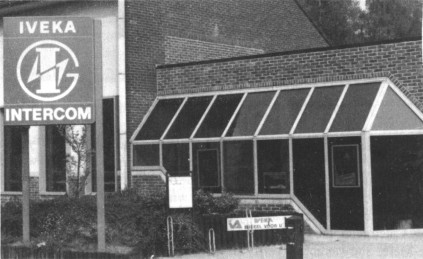
Iveka Intercom's Office at Herentals
By the time we'd said goodbye to our good "B&B" place at Heidehoff
and proceeded on to the city of Mons, the trunk of our car was so full of
insulators (many of which were cemented to heavy iron brackets) that our
suitcases were literally impacted! But we found a good inexpensive hotel there
and crashed early. It had been a long two days.
The next morning we asked the
hotel manager if she knew anything about the VERLICA BELGIUM Glass Factory,
located in the town of Ghlin, a short distance away from where we were in Mons.
She remembered working at the glass factory there a few years back, but it was
called VERLIPACK, not VERLICA BELGIUM. Carol and I were soon on our way to Ghlin
to see for ourselves. There it was -- VERLIPACK! The factory included
several large buildings.
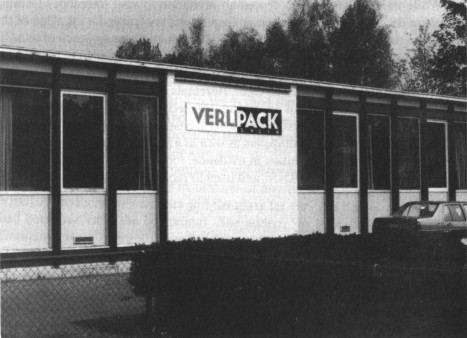
The security gate at Verlipack Glass Factory
At the security gate, we found a woman who had worked there for 20 years. She
insisted that VERLIPACK had never produced insulators, even though we showed her
some actual specimens, and that their line of products is and has been limited
to glass food containers and bottles for beer, wine, soft drinks and medicines.
But as we persisted with our questions, she finally put Carol on the phone with
Mrs. Emily Calemignn, the Public Relations person at VERLIPACK's main office in
Erpe-Mere. She was able to verify the fact that VERLICA BELGIUM was indeed the
name of the original factory established at Ghlin in about 1940. In 1970 the
name was changed to VERLIPACK. She promised to search through old company
records and find answers to other questions if we would put them in writing when
we returned to America. I did send her a follow-up letter and enclosed photos
of all known CD's of VERLICA BELGIUM insulators. At the time this article
needed to be on the editor's desk, I had not received an answer. I sincerely
hope that this company kept better records than VEGLA! But at least we learned
something!
Before we left Belgium we wanted to see the old Fuisseaux porcelain
factory at Baudour, which is now called NGK BAUDOUR S.A. It was just a few miles
away from Ghlin and we found it easily. The flags of Belgium and Japan flew
proudly side by side in front of the buildings. Fortunately, we were able to
speak with the Director and Technical manager of the plant, Mr. Mikio Ishikawa.
His name means "stone in the river." He was such a pleasant fellow and
so pleased that we were interested in the company that he gladly gave us quite a
bit of background information.
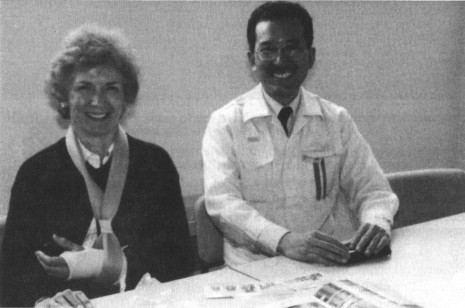
Marilyn and Mr. Mikio Ishikawa
The first factory was established in Baudour in 1842 by an engineer named
Francois Declercq, who had studied porcelain manufacturing in Saxony, Germany.
In 1880, the company was awarded to the Fuisseaux family by the French
government for having produced 270,000 porcelain insulators! Insulators were
marked simply "Defuisseaux Baudour". There were many different owners
of the company between 1880 and 1977 when the French government of this area of
Belgium invited NGK to join Baudour. Mr. Ishikawa stressed over and over that
NGK had been invited and had not barged in and taken over. He even insisted on
taking a picture of Carol and me (borrowing each of our cameras) standing by the
two flags so people in America would know that it was friendly merger.
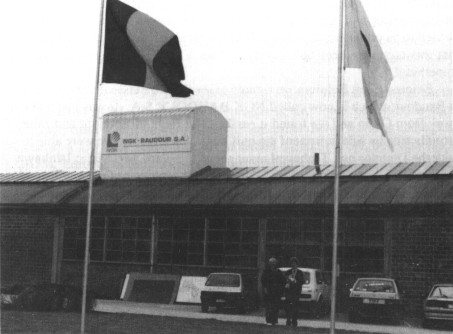
NGK Baudour - the friendly union
The present company logo is an artist's conception of a rocket launching pad
representing NGK's efforts to launch new ideas into the world in three areas:
Ceramic Ecology, Energy Distribution and Special Chemical Machines to Reduce
Garbage.

NGK Baudour's main products today are hollow porcelain shells for gas
circuit breakers, instrument transformers, bushings, arresters, condensers,
solid core post insulators, railway post insulators and distribution insulators.
We asked Mr. Ishikawa about the No Name U-2210's that we had seen everywhere and
he confirmed the fact that NGK Baudour produced them. They are unmarked because
only the larger insulators need to be identified as to what production lot they
came from or what date they were made. This is in case there are flaws in the
insulators that cause problems, other insulators made in the same production run
can be located and replaced. When an insulator manufactured by their plant is
marked with the company logo, the letters BB appear in place of NGK. This is for
BAUDOUR BELGIUM.
The U-2210's are all made by hand by one 60-year old man. He
works only part time but is the only person who has the knack. They would like
to phase him out because their small insulators are a drain on the company's
profit. But tradition has it that the Baudour factory has always supplied small
insulators to Intercom. However, once the man is retired (or fired) there will
be an excuse not to supply them any longer.
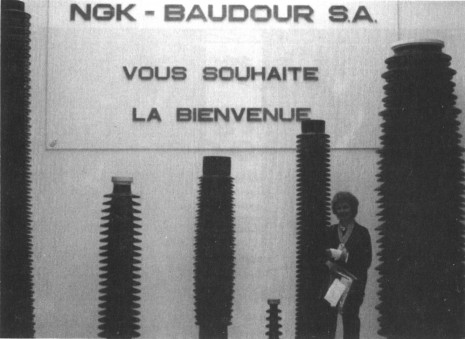
"NGK BAUDOUR S.A. Welcomes You."
Marilyn stands among some of the NGK products
manufactured at Baudour.
Because of the length of this article I am going to save France for the next
episode. But I did want to give you a sneak preview of one of Carols favorite
activities while in France. We thought it was so nice that everywhere we went
there was a "basin" provided that was just the right size for soaking
insulators!!
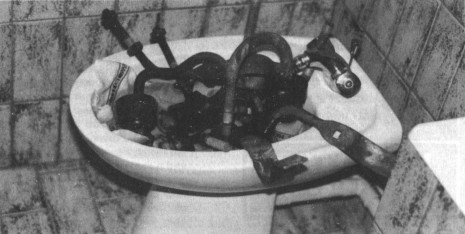
Coaxing the pins loose from CD's 459, 460, 571, 578 and 685.
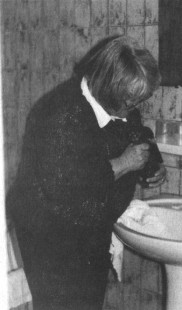
"Stab, twist, poke, grind !" |
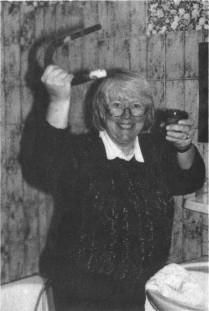
"Aha! Success!" |
| 